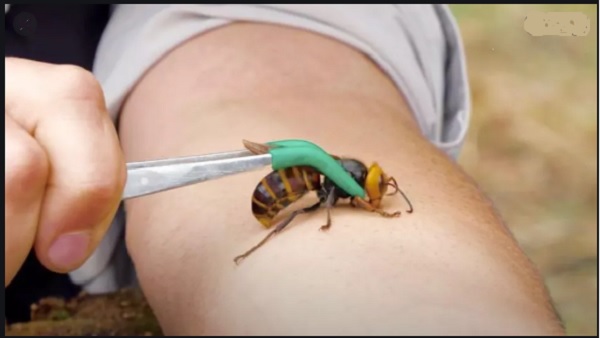The world’s largest hornet, a 2-inch killer dubbed the “Murder Hornet” with an appetite for honey bees, has been found in Washington state, USA; where entomologists were supposed to be making plans to wipe it out.
The giant Asian insect, with a sting that could be fatal to some people, is just now starting to emerge from winter hibernation.
“They’re like something out of a monster cartoon with this huge yellow-orange face,” said Susan Cobey, a bee breeder at Washington State University.
“It’s a shockingly large hornet,” said Todd Murray, a WSU Extension entomologist, and invasive species specialist. “It’s a health hazard, and more importantly, a significant predator of honey bees.”
The hornet was sighted for the first time in the U.S. last December, when the state Department of Agriculture verified two reports near Blaine, Washington, close to the Canadian border. It also received two probable, but unconfirmed reports from sites in Custer, Washington, south of Blaine.
The hornet can sting through most beekeeper suits, deliver nearly seven times the amount of venom as a honey bee, and sting multiple times, the department said, adding that it ordered special reinforced suits from China.
The university said it is not known how or where the hornets arrived in North America. This species normally lives in the forests and low mountains of eastern and southeast Asia and feeds on large insects, including wasps and bees. It was dubbed the “Murder Hornet” in Japan, where it is known to kill people.
The hornet’s life cycle begins in April, when queens emerge from hibernation, feed on plant sap and fruit, and look for underground dens to build their nests. Hornets are most destructive in the late summer and early fall. Like a marauding army, they attack honey bee hives, killing adult bees and devouring larvae and pupae, WSU said.
Their stings are big and painful, with a potent neurotoxin. Multiple stings can kill humans, even if they are not allergic, the university said.
Farmers depend on honey bees to pollinate many important northwest crops such as apples, blueberries, and cherries. With the threat from giant hornets, “beekeepers may be reluctant to bring their hives here,” said Island County Extension scientist Tim Lawrence.
We’ve had lots of questions about how Asian giant hornets compare in size to other similar-looking insects. Check out our new to-scale size comparison to see!
— WA St Dept of Agr (@WSDAgov) April 29, 2020
You can download a pdf of this image at https://t.co/cz5MK9SExt#asiangianthornet #invasivespecies pic.twitter.com/i6CXnT03eC
An invasive species can dramatically change growing conditions, Murray said, adding that now is the time to deal with the predators.
“We need to teach people how to recognize and identify this hornet while populations are small so that we can eradicate it while we still have a chance,” Murray said.
The state Department of Agriculture will begin trapping queens this spring, with a focus on Whatcom, Skagit, San Juan, and Island counties (in Washington State).
El avispón asiático gigante NO se ha detectado en México la solución NO es exterminar avispas o abejas, ya que muchas de ellas juegan un papel muy importante en los ecosistemas.
— CONABIO (@Conabio) May 12, 2020
?Las fotos de este tw son de especies nativas de México y Norteamérica. ?https://t.co/8AsHtaZSlg pic.twitter.com/2SfElaGhRu
Hunting the hornets is no job for ordinary people.
“Don’t try to take them out yourself if you see them,” Looney said. “If you get into them, run away, then call us!”
Mexico’s National Health Service, Food Safety, and Food Quality (SENASICA) that belongs to the Agriculture and Rural Development Ministry (SADER), has ordered a search for the giant Asian hornet in its epidemiological surveillance programs after the U.S. alert on the arrival of this invasive species.
In a statement, Senasica said that its objective is to protect nearly 43,500 bee producers that have over 2,172,000 beehives for honey production and the pollination of crops in the five producing regions in the country.
SENASICA said that although the plague is located in the northern border of the U.S. over 2,500 km away from Mexico, it is important to begin searching for the invasive species in case it reaches the country so as to act on time.
Ante la alerta emitida por Estados Unidos en referencia a la detección del avispón gigante asiático en Washington, @SENASICA instruyó que en sus programas de vigilancia epidemiológica se incluya la búsqueda de esta especie invasora.https://t.co/SYYNXM6jBo#AgriculturaMexicana pic.twitter.com/6ZZ06uyhsO
— Agricultura (@Agricultura_mex) May 10, 2020
In this vein, SENASICA said technicians working for the Agriculture Ministry must report any sighting of the giant hornets in the national territory through the AVISE app, to the e-mail [email protected] or to the phone number 800 7512100 .
Another of the actions implemented by SENASICA is for experts to inform producers about the risk of being stung by this insect, it could be lethal to people and animals as well, as the giant hornet’s venom is more powerful than any species in the American continent, and that, due to its size, common protection suits are not thick enough to prevent its sting.
Mexico’s Agriculture Ministry urged producers and the population in general to report any sighting of the giant hornets to the corresponding technical personnel and not to try to wipe them out or scare them by themselves, since it is unusual for these hornets to disturb people but will certainly sting if they feel threatened.
Source: El Universal

